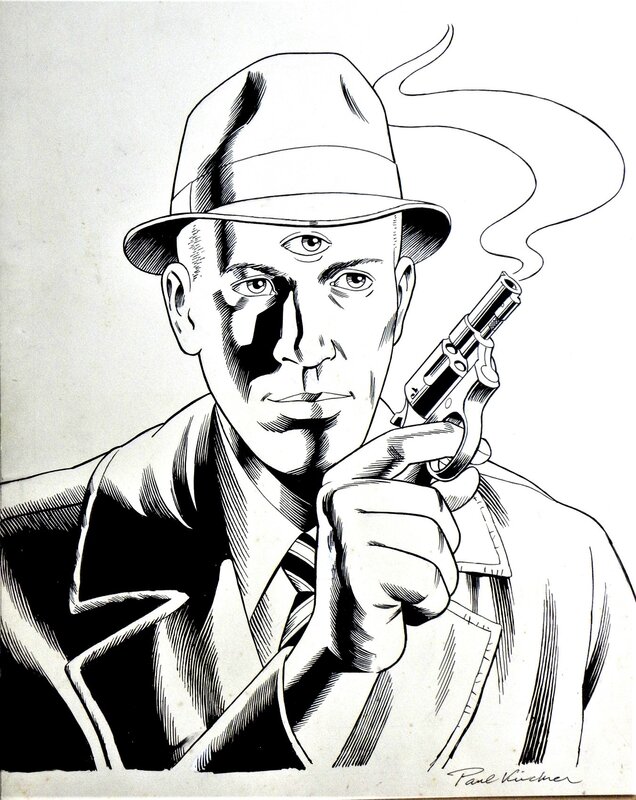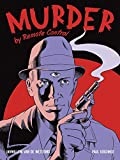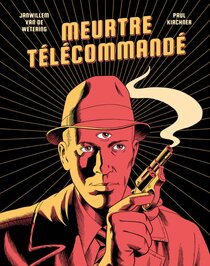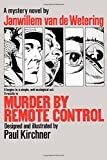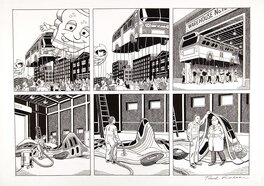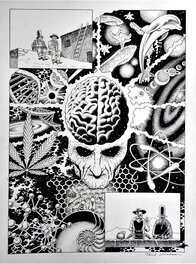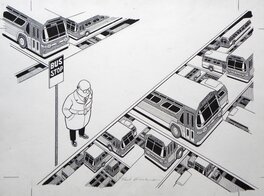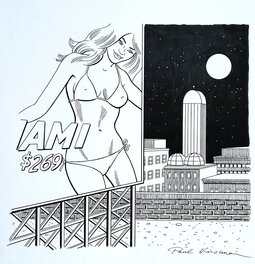In SupHermann 's collection
Description
Murder by remote control
- Edition (Néerlandaise) W & L Boeken, 1984 - Moord op afstand
- Edition (US) Random House, 1986
Couverture
- Réédition (US) Dover Comics & Graphic Novels, 2016
- Edition (Française) Tanibis, 2022 - Meurtre télécommandé
- Edition (Néerlandaise) W & L Boeken, 1984 - Moord op afstand
- Edition (US) Random House, 1986
Couverture
- Réédition (US) Dover Comics & Graphic Novels, 2016
- Edition (Française) Tanibis, 2022 - Meurtre télécommandé
Inscriptions
Signée par l’auteur. Réalisée dans les années 80 mais non publiée à l’époque
Comment
Kirchner a créé au fil des années un univers propre qui introduit du surréalisme et du psychédélisme dans des histoires au style réaliste.
L’auteur assume cette dichotomie et déclarera à plusieurs reprises lors d’interviews : « J’ai toujours eu l’intention de dessiner les visions avec le même réalisme que tout le reste. Pour moi, traiter l’irréel de façon réelle est l’essence du surréalisme. »
Son trait est assez marqué par l'école Hal Foster sous influence de Wally Wood dont il a été le collaborateur.
Ses planches sont souvent décoratives, en splash avec de belle irruptions graphiques.
On pourrait le qualifier d’auteur alternatif dans la mouvance de Burns ou Clowes.
Lors de la sortie de cet album, Gahan Wilson du The New York Times écrira : « Murder by Remote Control is an enjoyable entertainment that succeeds in demonstrating very effectively that this form of storytelling has a unique potential and can work a special kind of magic. »
Kirchner déclarera lors d’un interview à Paste pour la sortie de la réédition : « C’est un mystère de meurtre sur la côte du Maine, où vivait Janwillem. Le Maine a une grande variété de types vivant côte à côte: retraités riches, types de contre-culture et agriculteurs et pêcheurs locaux. Janwillem les a tous entrés dans l’histoire en tant que personnages et suspects. Le motif du meurtre est lié au conflit entre développement économique et préservation de l’environnement. Finalement, l’histoire sert de décor à une série de visions dépeintes comme des tableaux surréalistes »
Sélection Fauve Polar Festival d’Angoulême 2024
Critiques intéressantes
https://www.pastemagazine.com/comics/paul-kirchner-on-murder-by-remote-control-the-lost/
https://www.critiqueslibres.com/i.php/vcrit/64071
https://www.benzinemag.net/2022/11/28/meurtre-telecommande-de-paul-kirchner-cauchemar-u-s-en-cinemascope/
https://www.bdangouleme.com/selections-officielles-2023/album/96
L’auteur assume cette dichotomie et déclarera à plusieurs reprises lors d’interviews : « J’ai toujours eu l’intention de dessiner les visions avec le même réalisme que tout le reste. Pour moi, traiter l’irréel de façon réelle est l’essence du surréalisme. »
Son trait est assez marqué par l'école Hal Foster sous influence de Wally Wood dont il a été le collaborateur.
Ses planches sont souvent décoratives, en splash avec de belle irruptions graphiques.
On pourrait le qualifier d’auteur alternatif dans la mouvance de Burns ou Clowes.
Lors de la sortie de cet album, Gahan Wilson du The New York Times écrira : « Murder by Remote Control is an enjoyable entertainment that succeeds in demonstrating very effectively that this form of storytelling has a unique potential and can work a special kind of magic. »
Kirchner déclarera lors d’un interview à Paste pour la sortie de la réédition : « C’est un mystère de meurtre sur la côte du Maine, où vivait Janwillem. Le Maine a une grande variété de types vivant côte à côte: retraités riches, types de contre-culture et agriculteurs et pêcheurs locaux. Janwillem les a tous entrés dans l’histoire en tant que personnages et suspects. Le motif du meurtre est lié au conflit entre développement économique et préservation de l’environnement. Finalement, l’histoire sert de décor à une série de visions dépeintes comme des tableaux surréalistes »
Sélection Fauve Polar Festival d’Angoulême 2024
Critiques intéressantes
https://www.pastemagazine.com/comics/paul-kirchner-on-murder-by-remote-control-the-lost/
https://www.critiqueslibres.com/i.php/vcrit/64071
https://www.benzinemag.net/2022/11/28/meurtre-telecommande-de-paul-kirchner-cauchemar-u-s-en-cinemascope/
https://www.bdangouleme.com/selections-officielles-2023/album/96
Publications
Thematics
To leave a comment on that piece, please log in
About Paul Kirchner
Paul Kirchner is an American writer and illustrator who has worked in diverse areas, from comic strips and toy design to advertising and editorial art.
Paul Kirchner was born in New Haven, Connecticut. He attended Cooper Union School of Art but left in his third year, when, with the help of Larry Hama and Neal Adams, he began to get work in the comic book industry.
He penciled stories for DC’s horror line and assisted on Little Orphan Annie for Tex Blaisdell, who took over the strip after the death of Harold Gray.
In December 1973, Ralph Reese introduced Kirchner to Wally Wood, for whom he worked as assistant for several years.
Paul Kirchner's the bus ran as a series in Heavy Metal. In the mid-1970s, Kirchner wrote and illustrated the surrealistic comic strip Dope Rider for High Times.
For Heavy Metal he did an equally surrealistic monthly strip, the bus (1979–85). These strips were collected in a book published by Ballantine in 1987. A new edition has been released in 2012 by French publisher Tanibis.[2] Paul Kirchner also wrote and illustrated occasional short features for Heavy Metal and Epic Illustrated. Most of them were collected in the book Realms (Catalan Communications, 1987).

